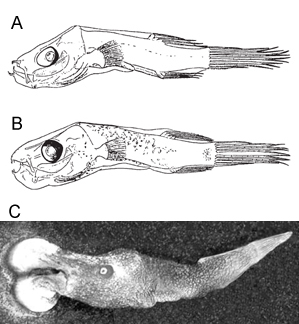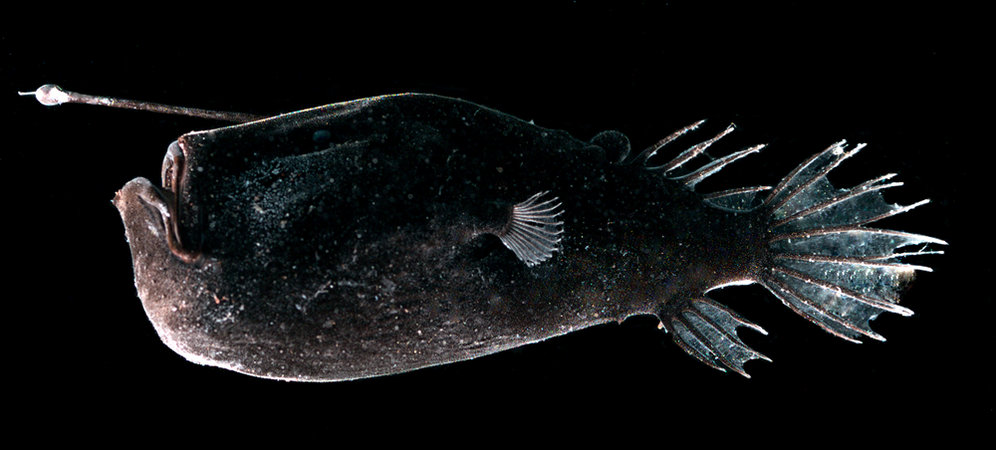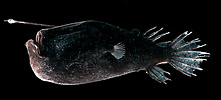Ceratiidae
Warty Seadevils
Theodore W. Pietsch- Ceratias
- Cryptopsaras
Introduction
The ceratioid family Ceratiidae contains relatively elongate, large-sized anglerfishes, easily separated from members of allied families by having the cleft of the mouth vertical to strongly oblique, the posterior end of the pterygiophore of the illicium emerging from the dorsal midline of the trunk, and two or three caruncles on the back just anterior to the origin of the soft-dorsal fin. The family consists of two genera, Ceratias Kröyer and Cryptopsaras Gill, and four species. The genus Ceratias is one of the commonest and best-known representatives of the lophiiform suborder Ceratioidei, now represented by over 260 metamorphosed females.
Characteristics
Diagnosis
Metamorphosed females of the family Ceratiidae are distinguished from those of all other ceratioid families by having a well-developed postmaxillary process of the premaxilla; posterior end of articular greatly expanded and squared off ventrally, sometimes terminating in an anterodorsally directed spine (Bertelsen, 1951:128, figs. 88, 89); two or three caruncles (modified dorsal-fin rays, each bearing a bioluminescent gland; see Brauer, 1908:105, pl. 32, fig. 17; Bertelsen, 1951:16, fig. 88B) on the dorsal midline of the trunk just anterior to the origin of the soft dorsal fin; and the posterior end of the pterygiophore of the illicium emerging from the dorsal midline just anterior to the caruncles (the later feature present elsewhere only in some species of Oneirodes and the thaumatichthyid genus Lasiognathus; see Bertelsen, 1943:190; Bertelsen, 1951:18-20, fig. 4).
Ceratiid females are further distinguished by having the following combination of character states: supraethmoid present; frontals meeting on the midline, each without a ventromedial extension; parietals large, considerably longer than wide, each overlapping respective frontal, sphenotic, pterotic, and epiotic; medial margin of each parietal contributing to formation of cranial trough, the latter deep and narrow, running full length of dorsal surface of skull; sphenotic spines absent; pterosphenoid absent (erroneously said to be present by Pietsch, 1986:480); metapterygoid and mesopterygoid present; hyomandibular with a double head; hypohyals 2; branchiostegal rays 6 (2 + 4); opercle bifurcate; subopercle elongate, anterior spine or projection present or absent; quadrate, articular, angular, and preopercular spines absent; jaws equal anteriorly; lower jaw with well-developed symphysial spine; anterior-maxillomandibular ligament present; pharyngobranchial I present or absent; pharyngobranchials II and III well-developed and heavily toothed; pharyngobranchial IV absent; ossified hypobranchials present; ossified basibranchials absent; epibranchial and ceratobranchial toothless; epibranchial I free from wall of pharynx; full length of ceratobranchial I bound to wall of pharynx by connective tissue; distal end of ceratobranchial I free, not bound by connective tissue to adjacent ceratobranchial II; proximal one-quarter to one-half of ceratobranchials II-IV not bound together by connective tissue; epurals absent; posterior margin of hypural plate with deep posterior notch; pterygiophore of illicium with a small second cephalic spine, bearing a distal bioluminescent gland, more-or-less concealed beneath skin just posterior to base of illicium; escal bulb and central lumen present, esca without tooth-like denticles; posteroventral process of coracoid present (Ceratias) or absent (Cryptopsaras); pectoral radials 4; pelvic bones cylindrical, without distal expansion; dorsal-fin rays (excluding the two or three reduced rays enveloped by caruncles) 4 (rarely 3 or 5); anal-fin rays 4; pectoral-fin rays 15-19 (rarely 14); caudal-fin rays 8-9 (8 in Cryptopsaras, the ninth or lowermost ray reduced to a small remnant in Ceratias), 2 simple + 4 bifurcated + 2 (or 3) simple; skin covered with close-set dermal spinules or spines (spines hypertrophied in Ceratias, especially in large females); ovaries paired; pyloric caecae 2 (see Clarke, 1950:10, fig. 3).


Males of the family Ceratiidae. A Ceratias sp., 10.8 mm, specimen sacrificed for histology (see Munk, 1964); B Cryptopsaras couesii, 10.2 mm, specimen sacrificed for histology (see Munk, 1964); C C. couesii, 10 mm, parasitically attached to a 45-mm female, ARC 8707665. © 2005 Theodore W. Pietsch
Males of the Ceratiidae are distinguished from those of all other ceratioid families by having the following combination of character states: free-living adolescent stages with eyes large, bowl-shaped, directed laterally, axis short, pupil much larger than lens; olfactory organs minute; a pair of large denticular teeth on snout, fused at base and articulating with pterygiophore of illicium (Bertelsen, 1951:129, fig. 89C, D); two pairs of denticular teeth on tip of lower jaw; premaxillae degenerate; jaw teeth absent; caruncles absent; fin-ray counts as given for metamorphosed females; skin naked and unpigmented in adolescent stages, spinulose and darkly pigmented in parasitic stages; obligatory sexual parasites as adults (see Pietsch, 2005).
Larval ceratiids are distinguished from those of other ceratioid families by having the following combination of character states: body "hump-backed"; skin moderately inflated; mouth subvertical; females with caruncles on dorsal midline of trunk; pectoral fins small, not reaching beyond dorsal and anal fins; pelvic fins absent; fin-ray counts as given for metamorphosed females; sexual dimorphism well developed, females with caruncles and distinct illicial rudiment; metamorphosis beginning at 8-10 mm SL (Bertelsen, 1951:135, 140, figs. 90, 93; 1984:329, fig. 168C-E).
Description
Metamorphosed females relatively long and slender; head length approximately 40% SL; greatest body depth approximately 50% SL; mouth large, cleft vertical to strongly oblique, not extending past eye; oral valve present; two nostrils on each side on distal surface of a rounded papilla; eye small, subcutaneous, appearing through a circular, translucent area of integument, nearly completely covered by darkly pigmented skin in largest known specimens; gill opening oval in shape, situated posterior to pectoral lobe; two or three caruncles on dorsal midline of trunk just anterior to origin of soft-dorsal fin; jaw teeth slender, recurved, depressible, those in lower jaw considerably larger and slightly more numerous than those in upper; vomer with or without teeth (see Pietsch, 1986:487, table 1); epibranchial I free from wall of pharynx; epibranchials I-IV closely bound together; full length of ceratobranchial I bound to wall of pharynx; epibranchial IV and ceratobranchial IV bound to wall of pharynx, no opening behind fourth arch; gill filaments present on epibranchials II-IV and full length of ceratobranchials II-IV; pseudobranch absent; illicium long (Ceratias) or extremely reduced and nearly totally enveloped by tissue of esca (Cryptopsaras); anterior end of pterygiophore of illicium exposed, emerging on head from between frontal bones just posterior to eye, its posterior end protruding on dorsal midline of trunk just anterior to caruncles; escal bulb oval in shape, with or without one or two distal appendages; neuromasts of acoustico-lateralis system located at tips of short cutaneous papillae, pattern of placement as described for other ceratioids (Pietsch, 1969, 1972, 1974a, 1974b).
Color of females in preservative dark red-brown to black over entire surface of body (except for distal portion of escal bulb) and oral cavity; skin unpigmented in adolescent males, darkly pigmented in parasitic stages; subdermal pigment present or absent; larvae with or without pigmentation.
Females represent the largest known ceratioids, attaining a standard length of at least 770 mm SL. All known free-living males (approximately 75 known specimens) measure less than 12 mm SL, whereas parasitically attached males (37 known specimens) range from 9.8 to about 140 mm SL (see Pietsch, 1976:786; 2005).
Distribution
Ceratiids are broadly distributed at meso- to bathypelagic depths in all three major oceans. Cryptopsaras couesii is found worldwide in tropical and subtropical latitudes. Members of the genus Ceratias are found from subarctic to subantarctic latitudes.
Key to Males and Females of Genera of the Family Ceratiidae
Key to Females
1A. Illicium long, considerably longer than length of escal bulb; two caruncles on dorsal midline of trunk just anterior to origin of soft-dorsal fin; subopercle without anterior spine (Ceratias Kröyer, 1845).
1B. Illicium short, nearly completely enveloped by tissue of escal bulb; three caruncles on dorsal midline of trunk just anterior to origin of soft-dorsal fin; subopercle with an anterior spine (Cryptopsaras Gill, 1883).
Key to Males
1A. Body without subdermal pigment (Ceratias Kröyer, 1845).
1B. Body with subdermal pigment on gill-cover, dorsal surface of trunk, and caudal peduncle (Cryptopsaras Gill, 1883).
References
Bertelsem, E. 1943. Notes on the deep-sea angler-fish Ceratias holbölli Kr. based on specimens in the Zoological Museum of Copenhagen. Vidensk. Medd. fra Dansk Naturh. Foren., 107: 185-206.
Bertelsen, E. 1951. The ceratioid fishes. Ontogeny, taxonomy, distribution and biology. Dana Rept., 39, 276 pp.
Bertelsen, E. 1984. Ceratioidei: Development and relationships. pp. 325-334, In: Moser, H. G., W. J. Richards, D. M. Cohen, M. P. Fahay, A. W. Kendall, Jr., and S. L. Richardson (editors), Ontogeny and Systematics of Fishes, Spec. Publ. No. 1, Amer. Soc. Ichthy. Herpet., ix + 760 pp.
Brauer, A. 1908. Die Tiefsee-fische. II. Anatomischer Teil. Wiss. Ergebn. Deut. Tiefsee-Exped. Valdivia, 15(2): 1-266.
Clarke, R. 1950. The bathypelagic angler fish Ceratias holbölli Kröyer. Disc. Rept., 26: 1-32.
Gill, T. N. 1883. Deep-sea fishing fishes. Forest and Stream, Nov. 8, 1883, p. 284.
Kröyer, H. N. 1845. Ichthyologiske bidrag (Fortsaettelse). 10. Ceratias holboelli Kr. Naturh. Tidsskr., 1844-1845, 2(1): 639-649.
Munk, O. 1964. The eyes of some ceratioid fishes. Dana Rept., 62, 17 pp.
Pietsch, T. W. 1969. A remarkable new genus and species of deep-sea anglerfish (family Oneirodidae) from off Guadalupe Island, Mexico. Copeia, 1969(2): 365-369.
Pietsch, T. W. 1972. A second specimen of the deep-sea anglerfish, Phyllorhinichthys micractis (family Oneirodidae), with a histological description of the snout flaps. Copeia, 1972(2): 335-340.
Pietsch, T. W. 1974a. Osteology and relationships of ceratioid anglerfishes of the family Oneirodidae, with a review of the genus Oneirodes Lütken. Nat. Hist. Mus. L. A. Co., Sci. Bull., 18, 113 pp.
Pietsch, T. W. 1974b. Systematics and distribution of ceratioid anglerfishes of the genus Lophodolos (family Oneirodidae). Breviora, 425: 1-19.
Pietsch, T. W. 1976. Dimorphism, parasitism and sex: reproductive strategies among deepsea ceratioid anglerfishes. Copeia, 1976(4): 781-793.
Pietsch, T. W. 1986. Systematics and distribution of bathypelagic anglerfishes of the family Ceratiidae (Order: Lophiiformes). Copeia, 1986(2): 479-493.
Pietsch, T. W. 2005. Dimorphism, parasitism, and sex revisited: modes of reproduction among deep-sea ceratioid anglerfishes (Teleostei: Lophiiformes). Ichthyol. Res., 52: 207-236.
About This Page
Theodore W. Pietsch

University of Washington, Seattle, Washington, USA
Correspondence regarding this page should be directed to Theodore W. Pietsch at and Christopher P. Kenaley at
Page copyright © 2005 Theodore W. Pietsch
 Page: Tree of Life
Ceratiidae. Warty Seadevils.
Authored by
Theodore W. Pietsch.
The TEXT of this page is licensed under the
Creative Commons Attribution-NonCommercial License - Version 3.0. Note that images and other media
featured on this page are each governed by their own license, and they may or may not be available
for reuse. Click on an image or a media link to access the media data window, which provides the
relevant licensing information. For the general terms and conditions of ToL material reuse and
redistribution, please see the Tree of Life Copyright
Policies.
Page: Tree of Life
Ceratiidae. Warty Seadevils.
Authored by
Theodore W. Pietsch.
The TEXT of this page is licensed under the
Creative Commons Attribution-NonCommercial License - Version 3.0. Note that images and other media
featured on this page are each governed by their own license, and they may or may not be available
for reuse. Click on an image or a media link to access the media data window, which provides the
relevant licensing information. For the general terms and conditions of ToL material reuse and
redistribution, please see the Tree of Life Copyright
Policies.
- First online 04 November 2005
- Content changed 17 April 2006
Citing this page:
Pietsch, Theodore W. 2006. Ceratiidae. Warty Seadevils. Version 17 April 2006 (under construction). http://tolweb.org/Ceratiidae/22010/2006.04.17 in The Tree of Life Web Project, http://tolweb.org/








 Go to quick links
Go to quick search
Go to navigation for this section of the ToL site
Go to detailed links for the ToL site
Go to quick links
Go to quick search
Go to navigation for this section of the ToL site
Go to detailed links for the ToL site